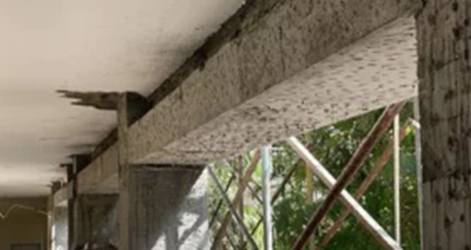Concrete beams are essential in every RCC structure. They support floors, roofs, and transfer loads across the framework. In Indian cities, many buildings are over 20 years old and show signs of distress. Cracks, deflections, and corrosion weaken the beam system. Without timely intervention, it may lead to partial or full collapse. This is where beam jacketing emerges as a reliable, affordable, and proven solution for preventing failure in such structures.
Why RCC Beams Fail Over Time
Beams made of reinforced concrete deteriorate over time for a variety of causes. In India, the process is accelerated by subpar construction, harsh weather, and neglect. The issue is exacerbated by seismic movements, overloading, and rusting reinforcement. These elements cause apparent spalling and fissures. Beams become harmful if they are ignored. As load-bearing capacity declines, the structure’s overall safety is put at danger. It’s important to understand the cause. More critically, though, in order to restore stability, we need to select an efficient repair technique, such as beam jacketing.
What Is Beam Jacketing and How Does It Work?
One technique for reinforcing a structure is beam jacketing. It entails encircling an existing beam with a coating of concrete or micro-concrete and reinforcing. The beam’s strength is restored and its load-bearing capability is increased by this extra layer. A formwork is set up and steel bars are secured. After that, a high-flow mix is placed, which adheres nicely to the existing concrete. The beam gets stronger once it hardens. The procedure is feasible for structures that are already in use because it doesn’t call for destroying the current construction.
Suitability of Beam Jacketing in Indian Structures
Beams in many Indian buildings were not initially intended to support the loads of today. For instance, residential structures that are transformed into commercial spaces frequently experience structural strain. In a similar vein, hospitals and institutions that are decades old require renovation to comply with safety regulations. Beam jacketing is the best option in these situations. It makes it possible to strengthen without leaving the area. Additionally, it is less expensive than reconstruction, in particular. This approach provides Indian property owners and contractors with a balance between dependability and affordability.
How Beam Jacketing Prevents Structural Failure
A beam’s ability to support loads is greatly reduced as it deteriorates. Its efficiency is decreased by steel corrosion, deflection, and cracks. In severe situations, this may result in floors sagging or even collapsing. By encasing the damaged beam in a strengthened shell, beam jacketing stops this from happening. Strength is restored by the steel and concrete additions. It boosts stress resistance and redistributes the strain. As a result, even under higher loads, the beam regains its integrity and avoids failure in the future.
Step-by-Step Process of Beam Jacketing
-
Inspection: Engineers examine the beam and determine the extent of damage.
-
Chipping: To reveal corroded reinforcing, loose concrete is removed.
-
Cleaning: The steel bars are either replaced or cleaned.
-
Reinforcement: More rebar is firmly fastened.
-
Formwork: The beam is surrounded by a mold.
-
Concreting: Micro-concrete or high-strength concrete is poured.
-
Curing: Bonding and strength growth are guaranteed by proper curing
Every step needs to be completed precisely. Beam jacketing is a permanent fix for structural damage when done properly.
Best Materials Used for Jacketing
Its performance is influenced by the jacketing materials chosen. Cost and availability are also factors in India. Because of its flowability, non-shrink micro-concrete is typically utilized. It is also possible to use cementitious grout with high strength. Tensile reinforcement is provided by extra steel bars. Durability is improved by corrosion inhibitors and bonding agents. Effective beam jacketing is ensured by the proper material mix. Additionally, it guarantees structural compatibility, particularly in older RCC buildings.
Advantages of Using Beam Jacketing
-
Boosts Load Capacity: Perfect for structures undergoing conversions.
-
Cost-effective: Far less expensive than rebuilding.
-
Minimal Disruption: No need to move residents.
-
Quicker Repair Time: It was finished in a few days.
-
Increased Durability: Guards against future deterioration and corrosion
-
Seismic Strengthening: Adds resistance to earthquake loads.
Beam jacketing is the ideal choice for fast and dependable strengthening in Indian cities that are undergoing rapid urban change.
Real-Life Applications in Indian Construction
Let’s look at a house in Pune that was built in the 1990s. Its beams were harmed over time by corrosion and water leaks. It would be costly and disruptive to replace them. Beam jacketing was suggested by the engineers. The building was reinforced in ten days. No renters needed to move. In India, similar instances can be observed in hospitals, shopping centers, and schools. Strengthening techniques that do not involve renovation or demolition is very beneficial to these organizations.
Beam Jacketing for Earthquake-Prone Zones
Safety is an issue in many earthquake zones in India. In areas like Himachal, Uttarakhand, and portions of Maharashtra, structures must be earthquake-resistant. Beam jacketing is essential in this refit situation. It makes beams more ductile and enables them to withstand seismic shocks. The chance of collapsing during shocks is decreased by this increased resilience. This approach to renovating buildings that are at risk is currently being actively promoted by local administrations and consultants.
Comparison with Other Strengthening Methods
There are further structural restoration methods, like carbon fiber wrapping and steel plating. But each has its limitations. Due to its weight, steel plating might not be appropriate for every construction. Fiber wrapping might not provide the same rigidity and calls for certain materials. Beam jacketing, on the other hand, is inexpensive, easy to manage locally, and straightforward. It blends ease of use with mechanical strength. This balance makes it more practical than more sophisticated alternatives, particularly in Indian construction.
Common Mistakes to Avoid in Beam Jacketing
Despite its dependability, failures may result from incorrect use. Important errors include:
- Using subpar steel or concrete
- Ignoring the need to prepare and clean surfaces
- Not correctly anchoring extra reinforcement
- disregarding the amount of moisture or the cure period
- Lack of a structural audit prior to application
Beam jacketing needs to be completed by qualified experts who comprehend the specifications for both design and execution in order to be successful.
Who Should Opt for Beam Jacketing?
It might be necessary to strengthen the beams in an aged RCC structure that you own or manage. Benefits can extend to factories, institutions, housing societies, and owners of commercial buildings. Beam jacketing should also be taken into consideration by builders working on load conversion or remodelling projects. This method is even employed by government agencies that care for historic structures. It maintains the original structure while guaranteeing adherence to contemporary safety regulations.
How Long Does It Last?
Beam jacketing can endure for at least 25 to 30 years if done correctly. Its efficacy is guaranteed by high-quality components, skillful construction, and routine examination. It also prevents additional corrosion from damaging the existing reinforcement. This extends the structure’s lifespan without requiring significant additional funding down the road. Long-term peace of mind is provided by this one-time fix, particularly in Indian cities with high population densities.
Choosing the Right Professionals for the Job
A successful beam jacketing job depends heavily on the contractor’s expertise. Look for teams that:
-
Conduct structural audits.
-
Recognize the behavior of RCC
-
Make use of the right tools and methods.
-
Provide paperwork and a post-repair examination.
-
Observe IS guidelines and best practices
Choosing the appropriate experts guarantees value for money, quality, and safety.
- Beam Jacketing Services Prevent Beam Failure in RCC Structures
- Prevent RCC beam failure with expert beam jacketing. Strengthen structures, restore safety, and extend life—ideal for Indian buildings needing repair.
- Beam Jacketing Services, Jacketing Services, Structural repair services
Related posts:
 Micro-Concrete Jacketing: Strengthen Your Structures for Long-Term Safety
Micro-Concrete Jacketing: Strengthen Your Structures for Long-Term Safety
 Revolutionizing property search with Reeltor your One Stop for Real Estate needs
Revolutionizing property search with Reeltor your One Stop for Real Estate needs
 Real Estate Investment in Pakistan: Understanding Market Cycles and Timing Your Purchase!
Real Estate Investment in Pakistan: Understanding Market Cycles and Timing Your Purchase!
 Adarsh Rosewood: A Residential Paradise in the Heart of East Bangalore
Adarsh Rosewood: A Residential Paradise in the Heart of East Bangalore
 2 BHK Living Redefined: Welcome to Adarsh Primrose in East Bangalore
2 BHK Living Redefined: Welcome to Adarsh Primrose in East Bangalore
 Fixed-Rate vs. Adjustable-Rate Mortgages: Which Is Smarter for you?
Fixed-Rate vs. Adjustable-Rate Mortgages: Which Is Smarter for you?
 How to Buy Your First Rental Property with Little Money Down
How to Buy Your First Rental Property with Little Money Down
 Why a Digital Marketing Course Is Your Key to Online Success
Why a Digital Marketing Course Is Your Key to Online Success







